This article was co-authored by Scott Tobis, MD and by wikiHow staff writer, Christopher M. Osborne, PhD. Dr. Scott Tobis is a board certified Urologist. With more than seven years of experience, he specializes in treating patients for urologic conditions such as urologic cancers, prostate enlargement, vasectomy, kidney stones, frequent/urgent urination, erectile dysfunction, incontinence, and blood in the urine. Dr. Tobis holds a BS in Cellular and Developmental Biology from The University of California, Santa Barbara, and an MD from Dartmouth Medical School. He completed his internship in General Surgery and residency in Urologic Surgery at the University of Rochester School of Medicine and Dentistry and his fellowship in Urologic Oncology and Robotic Surgery at The City of Hope National Medical Center. Dr. Tobis is a diplomat of the American Board of Urology.
There are 7 references cited in this article, which can be found at the bottom of the page.
wikiHow marks an article as reader-approved once it receives enough positive feedback. In this case, several readers have written to tell us that this article was helpful to them, earning it our reader-approved status.
This article has been viewed 1,087,265 times.
Is your foreskin tight and painful when you try to pull it back? Tight foreskin can be the result of inflammation, infection, or poor hygiene. Fortunately, you may be able to stretch your foreskin to reduce the tightness. Keep reading to learn how to gently pull your foreskin back without it hurting, plus when you may want to see a doctor.
Steps
Managing a Tight Foreskin
-
1Pull back your foreskin slowly and gently. In most cases, it's easy to use your fingers to slide your foreskin back and expose the head of your penis. If, however, you have a tighter-than-average foreskin, slide the foreskin back more slowly and deliberately to reduce pain and the chance of injury.[1] [2]
- If you feel pain (not just discomfort), stop trying to pull back your foreskin. You could cause a painful tear in the sensitive skin. Move on to trying methods to loosen the foreskin.
- A tight foreskin is known as phimosis. It's common for a child's uncircumcised penis to have this condition, but it typically goes away during adolescence. It can be an issue for adults as well, though.
- You can stretch your foreskin up to twice a day.[3]
-
2Retract your foreskin during a shower or bath. The warm water and moist air will help to soften and loosen the foreskin. Work slowly and carefully with your fingers to guide the foreskin back onto the shaft of your penis.[4]
- As a teen or adult, you should clean beneath your foreskin every time you bathe anyway. Pull the foreskin back, use a mild soap and lots of water to gently clean the area, rinse thoroughly, and guide the foreskin back into position.
-
3Pull a tight foreskin back incrementally over days or weeks. If you cannot retract your foreskin fully without pain because it's too tight, try slowly stretching it out. On the first day, gently pull the foreskin back until you feel discomfort. The next day, gently pull it slightly further back, and keep doing so once or twice per day for up to several weeks.[5] [6]
- Over time, this process will typically stretch out the foreskin and make it easier and more comfortable to pull back.
-
4Try more intensive foreskin-stretching exercises if needed. If the incremental approach isn't helping enough, try a more dedicated stretching program. If the ring at the tip of your foreskin is tight, use your fingers to gently stretch it wider for 20-30 seconds at a time. If other areas of your foreskin are tight, you can similarly use your hands to gently stretch those areas.[7]
- Do the exercises for 3-5 minutes, up to 3 times per day. It could take several weeks to a year or more to get noticeable results.
- You might also consider using a “flesh tunnel,” which is a silicone ring you place under the top ring of your foreskin for a few hours at a time each day. The device will help to incrementally stretch the foreskin.
- Stop the exercises if you experience pain, redness, or bleeding. Talk to your doctor for guidance.
-
5Consult your doctor for guidance on a painfully-tight foreskin. If stretching exercises don't help you retract your foreskin without pain, or if you deal with recurring redness, swelling, or discharge, talk to your doctor. They'll present you with appropriate medical treatment options.[8]
- They may prescribe a topical steroid cream for you to apply daily. Topical steroids help to stretch the foreskin.
- If you have an infection because of a tight foreskin, you might be prescribed an antifungal cream or antibiotics.
- In some cases, circumcision—the surgical removal of the foreskin—might be recommended as the best option. For adults, this is typically a quick procedure done under local anesthesia, with a healing time of 1 to 2 weeks.
Caring for a Child's Foreskin
-
1Do not force a child's foreskin to retract. At birth, and often for several years afterward, most or all of the foreskin usually remains attached to the head of the penis. The foreskin normally detaches from the penis tip (so that it can be retracted) by age 5, but it can take until puberty in some cases. Until that time, don't try to forcibly pull back a foreskin that is still attached.[9]
- Forcibly pulling back an attached foreskin will cause a great deal of pain and can lead to skin tears, bleeding, scarring, and possibly nerve damage.
-
2Don't worry about cleaning under a pre-pubescent child's foreskin. Before puberty, you generally don't need to pull back the foreskin to clean beneath it, even if it has detached from the head of the penis. Cleaning the outer surface of the penis regularly with a mild soap and clean water is sufficient under normal circumstances.[10]
- If smegma buildup is causing odor or discomfort, and the foreskin has detached so that it can be pulled back, go ahead and start cleaning beneath it.
- If smegma buildup is creating discomfort under a foreskin that hasn't yet detached, talk to a doctor for guidance.
-
3Teach the child to keep the foreskin clean once it can be pulled back. Once the foreskin detaches from the head of the penis and can be retracted, demonstrate proper cleaning technique to the child. Advise them to slowly pull back the foreskin to expose the penis head while bathing or showering.[11]
- After they pull back the foreskin, instruct them to gently wash the penis head and underside of the foreskin with a mild soap, rinse the area thoroughly with clean water, and slide the foreskin back into place.
-
4Consult a doctor if the foreskin won't retract after the onset of puberty. If a child's foreskin is still connected to the penis head after puberty begins, or if they can't retract it because it's too tight (phimosis), make an appointment with their doctor. The doctor might recommend foreskin stretching exercises, prescribe topical steroids, or simply advise a wait-and-see approach.[12]
- In rare cases, circumcision may be recommended as the best course of action for severe phimosis.
Addressing Other Foreskin Problems
-
1Get medical help if your foreskin is stuck in a retracted position. If you pull back your foreskin, exposing the head of your penis, but then are unable to slide the foreskin back over the head, you have a condition called paraphimosis. Because the retracted foreskin can cut blood flow to the tip of the penis, you should call your doctor or visit the hospital right away.[13]
- Taking a warm shower may help soften and expand the foreskin enough to solve the problem, but don't be too forceful in trying to slide the foreskin back in place. You could cause the skin to tear or other damage.
-
2Wash your penis regularly to prevent a buildup of smegma.[14] Smegma is nothing more than a buildup of shed skin cells underneath the foreskin. If you don't clean beneath your foreskin regularly, though, the smegma can develop a mucus-like texture and unpleasant odor, and can harbor bacteria that can lead to infection.[15]
- Teens and adults should clean beneath their foreskins every time they bathe or shower, using a mild soap and plenty of rinsing water.
- Younger children generally don't have to worry about smegma buildup, unless there is inflammation or discharge. In this case, see a doctor.
-
3Use topical medications to treat redness or inflammation. If you experience redness and/or inflammation on the underside of your foreskin, the tip of your penis, or both, a fungal infection is the most likely culprit. Apply an over-the-counter antifungal cream to the area (as per the product instructions) to see if the issue clears up within a few weeks.[16]
- If OTC antifungals don't help, or if the area becomes more painful, inflamed, or swollen, contact your doctor.
- Applying hydrocortisone cream can help you stretch your foreskin. Ask your doctor about a 1 month topical steroid treatment.[17]
Expert Q&A
-
QuestionHow can I loosen my skin phimosis?
 Scott Tobis, MDDr. Scott Tobis is a board certified Urologist. With more than seven years of experience, he specializes in treating patients for urologic conditions such as urologic cancers, prostate enlargement, vasectomy, kidney stones, frequent/urgent urination, erectile dysfunction, incontinence, and blood in the urine. Dr. Tobis holds a BS in Cellular and Developmental Biology from The University of California, Santa Barbara, and an MD from Dartmouth Medical School. He completed his internship in General Surgery and residency in Urologic Surgery at the University of Rochester School of Medicine and Dentistry and his fellowship in Urologic Oncology and Robotic Surgery at The City of Hope National Medical Center. Dr. Tobis is a diplomat of the American Board of Urology.
Scott Tobis, MDDr. Scott Tobis is a board certified Urologist. With more than seven years of experience, he specializes in treating patients for urologic conditions such as urologic cancers, prostate enlargement, vasectomy, kidney stones, frequent/urgent urination, erectile dysfunction, incontinence, and blood in the urine. Dr. Tobis holds a BS in Cellular and Developmental Biology from The University of California, Santa Barbara, and an MD from Dartmouth Medical School. He completed his internship in General Surgery and residency in Urologic Surgery at the University of Rochester School of Medicine and Dentistry and his fellowship in Urologic Oncology and Robotic Surgery at The City of Hope National Medical Center. Dr. Tobis is a diplomat of the American Board of Urology.
Board Certified Urologist Patients with mild phimosis (narrowing of the foreskin) can gently stretch the skin by gradually and progressively retracting the skin back more and more until the foreskin can be completely pulled back. This can be done twice a day, trying each time to pull the skin back a little further.
Patients with mild phimosis (narrowing of the foreskin) can gently stretch the skin by gradually and progressively retracting the skin back more and more until the foreskin can be completely pulled back. This can be done twice a day, trying each time to pull the skin back a little further. -
QuestionShould it hurt when pulling back foreskin?
 Scott Tobis, MDDr. Scott Tobis is a board certified Urologist. With more than seven years of experience, he specializes in treating patients for urologic conditions such as urologic cancers, prostate enlargement, vasectomy, kidney stones, frequent/urgent urination, erectile dysfunction, incontinence, and blood in the urine. Dr. Tobis holds a BS in Cellular and Developmental Biology from The University of California, Santa Barbara, and an MD from Dartmouth Medical School. He completed his internship in General Surgery and residency in Urologic Surgery at the University of Rochester School of Medicine and Dentistry and his fellowship in Urologic Oncology and Robotic Surgery at The City of Hope National Medical Center. Dr. Tobis is a diplomat of the American Board of Urology.
Scott Tobis, MDDr. Scott Tobis is a board certified Urologist. With more than seven years of experience, he specializes in treating patients for urologic conditions such as urologic cancers, prostate enlargement, vasectomy, kidney stones, frequent/urgent urination, erectile dysfunction, incontinence, and blood in the urine. Dr. Tobis holds a BS in Cellular and Developmental Biology from The University of California, Santa Barbara, and an MD from Dartmouth Medical School. He completed his internship in General Surgery and residency in Urologic Surgery at the University of Rochester School of Medicine and Dentistry and his fellowship in Urologic Oncology and Robotic Surgery at The City of Hope National Medical Center. Dr. Tobis is a diplomat of the American Board of Urology.
Board Certified Urologist Only if you have phimosis. If it hurts and you can't retract your foreskin, you can use a short (1 month or less) course of a steroid cream like hydrocortisone. As always, discuss the situation with your doctor first.
Only if you have phimosis. If it hurts and you can't retract your foreskin, you can use a short (1 month or less) course of a steroid cream like hydrocortisone. As always, discuss the situation with your doctor first.
References
- ↑ Scott Tobis, MD. Board Certified Urologist. Expert Interview. 26 August 2021.
- ↑ https://www.healthychildren.org/English/ages-stages/baby/bathing-skin-care/Pages/Care-for-an-Uncircumcised-Penis.aspx
- ↑ Scott Tobis, MD. Board Certified Urologist. Expert Interview. 26 August 2021.
- ↑ https://www.healthychildren.org/English/ages-stages/baby/bathing-skin-care/Pages/Care-for-an-Uncircumcised-Penis.aspx
- ↑ Scott Tobis, MD. Board Certified Urologist. Expert Interview. 26 August 2021.
- ↑ https://www.themix.org.uk/your-body/mens-health/foreskin-problems-7275.html
- ↑ https://www.wikihow.fitness/Do-Phimosis-Stretching
- ↑ https://www.nhs.uk/conditions/phimosis/
- ↑ https://raisingchildren.net.au/guides/a-z-health-reference/foreskin
- ↑ https://www.healthychildren.org/English/ages-stages/baby/bathing-skin-care/Pages/Care-for-an-Uncircumcised-Penis.aspx
- ↑ https://www.healthychildren.org/English/ages-stages/baby/bathing-skin-care/Pages/Care-for-an-Uncircumcised-Penis.aspx
- ↑ https://raisingchildren.net.au/guides/a-z-health-reference/foreskin
- ↑ https://youngmenshealthsite.org/askus/pain-retracting-foreskin/
- ↑ Scott Tobis, MD. Board Certified Urologist. Expert Interview. 26 August 2021.
- ↑ https://www.healthychildren.org/English/ages-stages/baby/bathing-skin-care/Pages/Care-for-an-Uncircumcised-Penis.aspx
- ↑ https://www.themix.org.uk/your-body/mens-health/foreskin-problems-7275.html
- ↑ Scott Tobis, MD. Board Certified Urologist. Expert Interview. 26 August 2021.
About This Article
To pull your foreskin back without pain, try to gently guide the foreskin back onto the shaft of your penis during a shower or bath since the warm water will soften your skin. If your foreskin feels too tight, then work on slowly pulling it back a little bit every day for several weeks to allow the skin to stretch. If stretching doesn’t help or you experience recurring redness, swelling, or discharge, then talk to your doctor about treatment options, which may include steroid cream, antifungal cream, or antibiotics. To learn how to care for your child’s foreskin, keep reading!



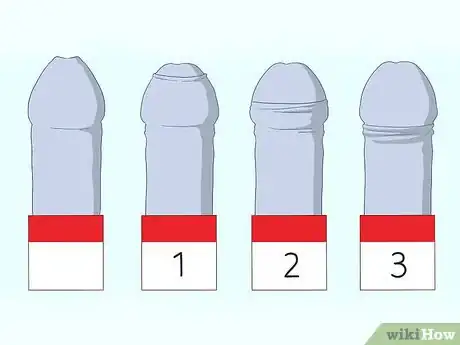

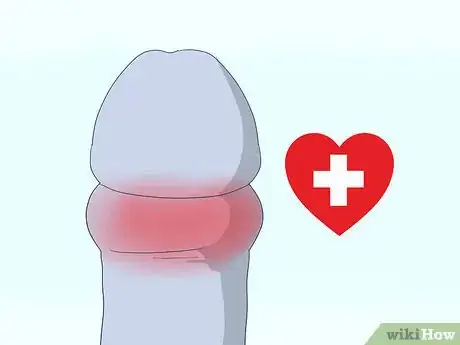

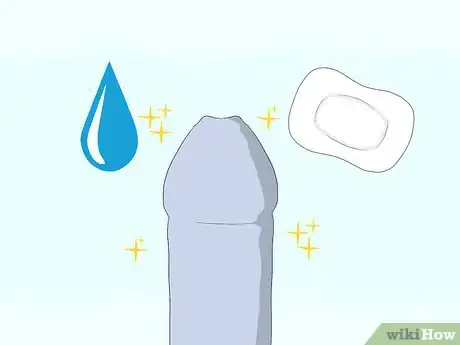

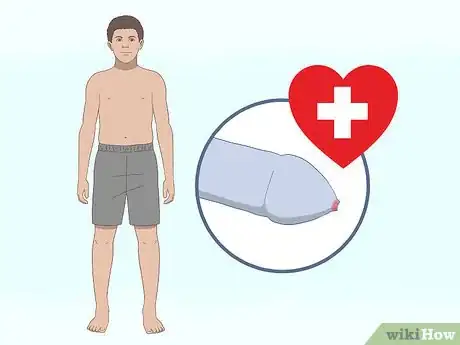


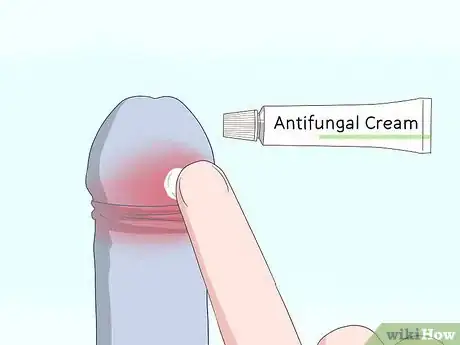
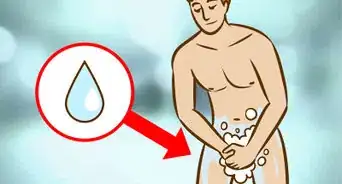
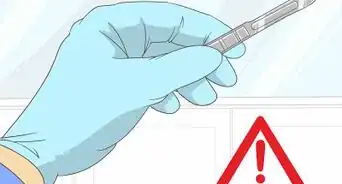



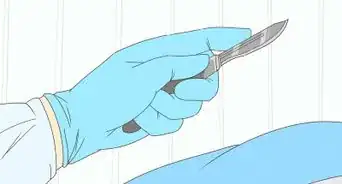






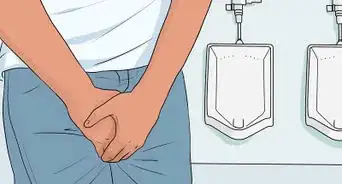









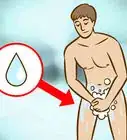

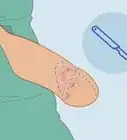




































Medical Disclaimer
The content of this article is not intended to be a substitute for professional medical advice, examination, diagnosis, or treatment. You should always contact your doctor or other qualified healthcare professional before starting, changing, or stopping any kind of health treatment.
Read More...